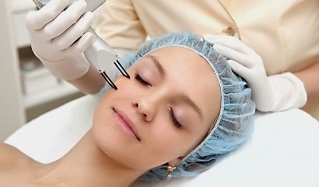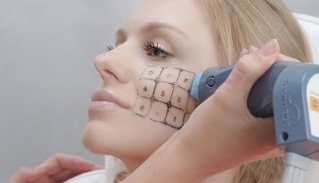Too bad, it looks like I'm still young - and wrinkles, age spots, and other cosmetic blemishes have already appeared. You can get rid of it with a fractional rejuvenation procedure. How does it work?
You always want to look beautiful, regardless of age. But time goes on inexorably and is reflected in appearances. Over the years, the skin becomes less elastic, wrinkles, age spots and other visible blemishes appear. Modern technology allows you to prolong youth, using laser exposure on problem areas. Let's find out fractional rejuvenation: what it is, how it occurs and the results of this procedure.
What is

Cells lose their activity over time, which slows down the regeneration process. It is important to restore youthfulness not only visually, but also to help cells recover and continue their active work. Only in this way will the skin get a healthy, firm and smooth appearance.
The first fractional laser rejuvenation was performed in 2004. It was developed specifically to treat signs of aging. After the first studies were obtained and the results with excellent effect, this procedure began to be actively used in many beauty salons. This action is completely safe, effectively combats cosmetic defects.
Advantages and execution techniques
Laser rejuvenation has several uses to illustrate why this anti-aging method is useful:
- one procedure is enough for a good result;
- no anesthetic was used;
- is not an operation;
- safe, without side effects;
- does not need long rehabilitation time;
- the effect is similar to the Botox injection technique;
- has a long duration.
This rejuvenation method is called fractional, because it only affects the problem area that is exposed to a small laser beam. The untouched area, namely the epidermal cells, actively begins to work, multiply, and rapidly heal the laser treated area. The full rehabilitation period lasts no more than three days, depending on the skin condition. Collagen is actively produced in cells, which in turn:
- smoothes wrinkles, creases;
- skin is tightened;
- oval faces are aligned;
- pigment spots become lighter.

This procedure is painless, painless, and the redness disappears quickly. The fractional laser action is somewhat similar to the beam resurfacing method, but it has more and more capabilities. In another way, this is called photorejuvenation.
The principle of action is that skin that is damaged is exposed to heat shock at a fairly high temperature range. The beautician uses a small apparatus on which the elements are attached, which are used to penetrate the laser beam. Because the rays are so hot, the skin is processed very quickly to avoid burns.
The result depends on the severity of the damage. The deeper the wrinkles, the more treatment is required. The healing time also depends on the individual and his health condition.
A laser beam effect that is thinner than two hundred microns is sufficient for the skin, so that a new layer of epidermis appears on the treated area. Its rays are similar to thin webs and are applied exclusively to problem areas, on the face, neck, legs, around the eyes. This mesh allows not to affect the surrounding area, and to enable them to activate cell healing and restoration.
Photo refresh type
In the field of cosmetology, two types of fractional thermolysis are used, which differ from each other in the degree of impact and basic characteristics.
- Ablative method- thermoactivity acts on the top layer of the skin, on the cells.
- Non-relational rejuvenation- the laser beam acts exclusively on the inner layers of the epidermis.
Many fractional machines today use CO2 laser light. They are more advanced and have moved to new levels over the last few years. Before starting the procedure, it is worth clarifying which laser to use, the quality and efficiency of which depend on it.
In order to achieve the best effect, it is recommended to combine two types of fractional thermolysis - ablative and non-relativistic. The double impact legs help to increase the yield and maintain it for a long time. Thanks to modern equipment, beauticians have developed a rejuvenation program for skin type and health status.
When to decline

Like other interventions in the natural functioning of the body, fractional facial rejuvenation has contraindications. The Ft procedure should not be performed if:
- You are pregnant;
- has epilepsy;
- for oncology;
- severe skin inflammation, with psoriasis;
- for herpes;
- if you have recently had chemical peeling on your face;
- or sunbathing;
- has vitiligo;
- chronic diseases such as diabetes mellitus, bad blood clotting.
Contraindications should not be ignored, as problems can be greatly activated by heat exposure and exacerbate the situation.
What to Expect
Photothermolysis is intended for facial lifting and skin rejuvenation. With the help of cosmetic procedures, you immediately notice how the skin is tightened, wrinkles disappear within a few days and the outline becomes clearer. To make the effect even better, it is advisable to carry out several procedures with a difference of from one month to six months, depending on the first results.
To improve facial conditions, many cosmetologists recommend a combination of fractional types of CO2 laser exposure. This, in turn, allows you to maintain your youth for a long time, prolongs the skin regeneration process and prevents premature aging.
The patient recovered quite quickly, within one week. The timing also depends directly on the type selected. In the first day or two, the skin feels swollen, there is redness. However, after 4–5 days, the dead skin cells are shed from the skin, the epidermis is covered with a new and healthy layer. If you coordinate your actions correctly, choose a good and responsible cosmetologist, find out if there are contraindications, then the photorejuvenation procedure is only for good.














































































